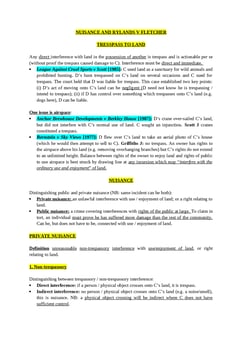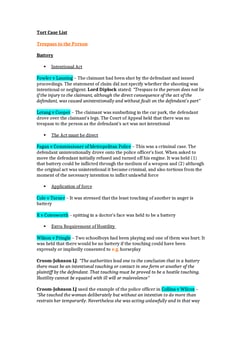Taylor v A Novo [2013] EWCA Civ 194; [2014] QB 150; [2013] 3 WLR 989
Judgement for the case Taylor v A Novo
Table Of Contents
KEY POINTS
-
Negligence refers to the failure to exercise reasonable care, resulting in harm or injury to another person or property.
It encompasses actions that fall below the standard of care expected in a given situation and lead to foreseeable consequences.
Foreseeability of consequential injury pertains to the reasonable anticipation or expectation of potential harm or injury that may result from negligent actions or omissions.
It is crucial in determining liability, as the law often requires that the harm be reasonably foreseeable to hold a party accountable for their negligence.
-
Nervous shock, also known as emotional distress or psychological trauma, refers to the intense emotional reaction or mental anguish experienced by an individual due to a shocking or traumatic event.
It can manifest in various forms such as anxiety, depression, or post-traumatic stress disorder (PTSD).
The claimant may seek legal recourse to hold the defendant accountable for the harm inflicted by pursuing compensation for medical expenses, pain and suffering, and other related damages.
The traumatic nature of the event and its aftermath lead to significant psychological distress for the claimant, prompting consideration of legal recourse for compensation and support.
FACTS
-
In this case, Cindy Janet Taylor (“Claimant's mother”) sustained injuries to her head and foot in an accident resulting from A Novo’s (Defendant) negligence.
Approximately three weeks later, while in the process of recovering at home from her injuries, the mother unexpectedly collapsed and tragically passed away.
Crystal Taylor (“Claimant”) having directly witnessed her mother's collapse and subsequent death, suffered from psychiatric illness, specifically post-traumatic stress disorder (PTSD).
Seeking legal recourse, the Claimant pursued damages against the Defendant.
-
During the trial, Judge Halbert (Judge) determined that the event directly responsible for the Claimant's harm was the sudden death of her mother.
Crucially, the Judge found no temporal gap between the initial injury suffered by the mother three weeks earlier and her subsequent demise.
Moreover, the Judge concluded that the Claimant's psychiatric injury was a reasonably foreseeable consequence of the Defendant's negligence.
-
The Judge ruled in favour of the Claimant, awarding damages.
However, the Defendant lodged an appeal, contesting the judgment because the relationship between the parties lacked sufficient proximity.
The Defendant argued that since the Claimant was not present at the scene of her mother's accident or its immediate aftermath, the connection between them did not meet the requisite standard of proximity.
JUDGEMENT
The appeal was successful.
It was ruled that for a Claimant to be considered a secondary victim of the Defendant's negligence, they needed to demonstrate a close relationship with the Defendant and physical proximity to the negligent event.
-
The court emphasised that this physical proximity was not only necessary but also acted as a control mechanism to limit claims for psychiatric injury.
Extending liability beyond this would require legislative action, not judicial interpretation.
In this case, the Claimant's mother's death, occurring three weeks after the initial accident, was not deemed proximate enough to hold the defendant liable for the Claimant's psychiatric illness.
Therefore, while the Claimant could have claimed damages if her illness stemmed from witnessing the accident directly, she could not do so for witnessing her mother's subsequent death.
COMMENTARY
-
This case provides a concise overview of key legal concepts such as negligence, foreseeability of consequential injury, and nervous shock, highlighting their significance in determining liability and seeking legal recourse for damages.
It outlines the tragic circumstances of Cindy Janet Taylor's accident and subsequent death, leading to her daughter, Crystal Taylor, suffering from post-traumatic stress disorder (PTSD).
-
Judge Halbert's ruling, based on the lack of a temporal gap between the initial injury and subsequent demise, underscores the foreseeability of the claimant's psychiatric injury as a consequence of the Defendant's negligence.
Despite the initial judgment in favour of the Claimant, the Defendant's successful appeal emphasises the importance of a close relationship and physical proximity to the negligent event for a claimant to be considered a secondary victim.
This case reminds us of the legal principles surrounding liability and the careful consideration needed when determining the extent of responsibility in cases involving psychiatric injury due to negligence.
For Further Study on Taylor v A Novo

Tort Law notes fully updated for recent exams at Oxford and Cambridg...
Need instant answers? Our AI exam tutor is here to help.
Ask questions 🙋 Get answers 📔 It's simple 👁️👄👁️
Our AI is educated by the highest scoring students across all subjects and schools. Join hundreds of your peers today.
Get StartedSimilar Cases
Related Product Samples
These product samples contain the same concepts we cover in this case.
| GDL Tort Law | Negligence Psychiatric Harm Notes (5 pages) |
| GDL Tort Law | Negligence Nervous Shock Notes (14 pages) |
| Tort Law | Nervous Shock Notes (4 pages) |
| GDL Tort Law | Psychiatric Injury Notes (8 pages) |

